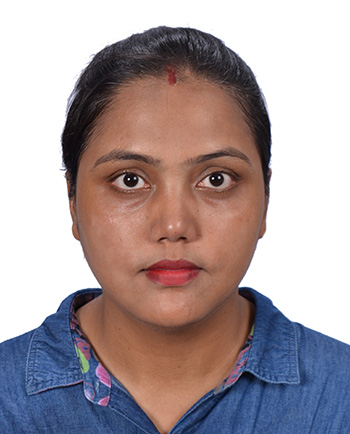个人主页
教育背景
2008-2011 - 博士(植物学), 贝拿勒斯印度教大学/CSIR-国家植物研究所
2002-2004 - 硕士, 贝拿勒斯印度教大学
1999-2002 – 学士, 贝拿勒斯印度教大学
工作经历
2021-至今 - 副研究员, 中国科学院西双版纳热带植物园
2017-2021 - 博士后, 中国科学院西双版纳热带植物园
2015-2017 - 青年科学家, 科学与工程研究委员会,科学和技术系
2012-2015 - 博士后, 贝拿勒斯印度教大学
2008-2011 - CSIR-高级研究员, 国家植物研究所
2004-2008 - 项目助理, CSIR-高级研究员
代表论著
1. Mishra S., Wang W., de Oliveira I.P., Atapattu A.J., Xia S.W., Grillo R., Lescano C.H. and Yang X. 2021. Interaction mechanism of plant-based nanoarchitectured materials with digestive enzymes of termites as target for pest control: Evidence from molecular docking simulation and in vitro studies. Journal of Hazardous Materials, 403, p.123840.
2. Atapattu A.J., Xia S.W., Cao M., Zhang W.F., Mishra S. and Yang X. 2020. Can Dominant Canopy Species Leaf Litter Determine Soil Nutrient Heterogeneity? A Case Study in a Tropical Rainforest in Southwest China. Journal of Soil Science and Plant Nutrition, 20(4), pp.2479-2489.
3. Mishra S., Yang X., Ray Shatrupa, Fraceto L.F. and Singh H.B. 2020. Antibacterial and biofilm inhibition activity of biofabricated silver nanoparticles against Xanthomonas oryzae pv. oryzae causing blight disease of rice instigates disease suppression. World Journal of Microbiology and Biotechnology, 36(4), 1-10.
4. Mishra S., H?ttenschwiler Stephan, Yang X. 2020. The plant microbiome: A missing link for the understanding of community dynamics and multifunctionality in forest ecosystems. Applied Soil Ecology, 145, 103345.
5. Mishra S., Yang X., Singh H.B. 2020. Evidence for positive response of soil bacterial community structure and functions to biosynthesized silver nanoparticles: An approach to conquer nanotoxicity? Journal of Environmental Management, 253, 109584.
6. Saxena A., Mishra S., Ray S., Raghuwanshi R, Singh H. B. 2020. Differential Reprogramming of Defense Network in Capsicum annum L. Plants Against Colletotrichum truncatum Infection by Phyllospheric and Rhizospheric Trichoderma Strains. Journal of Plant Growth Regulation 39, pages751–763
7. Ray, S., Mishra, S., Bisen, K., Singh, S., Sarma, B.K. and Singh, H.B. 2018. Modulation in phenolic root exudate profile of Abelmoschus esculentus expressing activation of defense pathway. Microbiological Research, 207, pp.100-107.
8. Mishra S., Yang X., Singh H.B. 2019. Creating a global database “Nanomaterials in the soil environment”: future need for the terrestrial ecosystem. Energy, Ecology & Environment 4: 271–285.
9. Fraceto L.F., Maruyama C.R., Guilger M., Mishra S., Keswani C., Singh H.B. and de Lima R. 2018. Trichoderma harzianum‐based novel formulations: potential applications for management of Next‐Gen agricultural challenges. Journal of Chemical Technology & Biotechnology 93: 2056–2063.
10. Mishra S., Keswani C., Abhilash P.C., Fraceto L.F., Singh H.B. 2017. Integrated Approach of Agri-nanotechnology: Challenges and Future Trends. Frontiers in Plant Science 8: 471.
11. Mishra S., Singh B.R., Naqvi A.H., Singh H.B. 2017. Potential of biosynthesized silver nanoparticles using Stenotrophomonas sp. BHU-S7 (MTCC 5978) for management of soil-borne and foliar phytopathogens. Scientific Reports 7: 45154.
12. Mishra S., Singh H.B. 2015. Silver nanoparticles mediated altered gene expression of melanin biosynthesis genes in Bipolaris sorokiniana. Microbiological Research 172: 16-18.
13. Mishra S., Singh H.B. 2015. Biosynthesized silver nanoparticles as a nanoweapon against phytopathogens: exploring their scope and potential in agriculture. Applied Microbiology and Biotechnology 99:1097–1107 1432-0614 3.337
14. Mishra S., Singh B.R., Singh A., Keswani C., Naqvi A.H., Singh H.B. 2014. Biofabricated silver nanoparticles act as a strong fungicide against Bipolaris sorokiniana causing spot blotch disease in wheat. PLOS ONE 9(5): e97881.
15. Keswani C., Mishra S., Sarma B.K., Singh S.P., Singh H.B. 2014. Unraveling the efficient applications of secondary metabolites of various Trichoderma spp. Applied Microbiology and Biotechnology 98:533–544.
16. Mishra S., Srivastava S., Nautiyal C.S. 2014. Differential gene expression pro?le in Pseudomonas putida NBRIC19-treated wheat (Triticum aestivum) plants subjected to biotic stress of Parthenium hysterophorus. Molecular Biology Reports 41:1385–1399.
17. Nautiyal C.S., Srivastava S., Mishra S., Asif M.H., Chauhan P.S., Singh P.C., Nath P. 2013. Reduced cell wall degradation plays a role in cowdung-mediated management of wilt complex disease of chickpea. Biology and Fertility of Soils 49:881–891.
18. Tripathi P., Singh P.C., Mishra A., Chaudhry V., Mishra S., Tripathi R.D., Nautiyal C.S. 2013. Trichoderma inoculation ameliorates arsenic induced phytotoxic changes in gene expression and stem anatomy of chickpea. Ecotoxicology and Environmental Safety 89:8-14.
19. Niranjan A., Mishra S., Lehri A., Amla D.V., Upadhyay R.S., Nautiyal C.S. 2013. Validation of an HPLC-PDA-MS-MS methodology for the identification and quantification of heterologous compounds parthenin and polyphenols in Parthenium hysterophorus L. Analytical Letters 46:48–59.
20. Mishra S., Upadhyay R.S., Nautiyal C.S. 2013. Unravelling the beneficial role of microbial contributors in reducing the allelopathic effects of weeds. Applied Microbiology and Biotechnology 97:5659–5668
21. Mishra S., Mishra A., Chauhan P. S., Mishra S. K., Kumari M., Niranjan A., Nautiyal C.S. 2012. Pseudomonas putida NBRIC19 dihydrolipoamide succinyltransferase (SucB) gene controls degradation of toxic allelochemicals produced by Parthenium hysterophorus. Journal of Applied Microbiology 112: 793–808.
22. Mishra S., Nautiyal C.S. 2012. Reducing the allelopathic effect of Parthenium hysterophorous L. on wheat (Triticuma estivum L.) by Pseudomonas putida. Plant Growth Regulation 66:155–165
23. Mishra S., Chauhan P.S., Goel A.K., Upadhyay R.S., Nautiyal C.S. 2012. Pseudomonas putida NBRIC19 provides protection to neighboring plant diversity from invasive weed Parthenium hysterophorus L. by altering soil microbial community. Acta Physiologiae Plantarum 34:2187–2195.
24. Chauhan P.S., Chaudhary V., Mishra S., Nautiyal C.S. 2011. Uncultured bacterial diversity in tropical maize (Zea mays L.) rhizosphere. Journal of Basic Microbiology 51:15–32.
25. Srivastava S., Yadav A., Seem K., Mishra S., Chaudhary V., Nautiyal C.S. 2008. Effect of high temperature on Pseudomonas putida NBRI0987 biofilm formation and expression of stress sigma factor RpoS. Current Microbiology 56: 453-457.
专著
Singh H.B., Mishra S., Fraceto L.F., De Lima R. (2018) Emerging Trends in Agri-Nanotechnology: Fundamental and Applied Aspects. CABI, UK, ISBN- 9781786391445
承担科研项目情况
2017–2021, 中国科学院博士后项目, 地下土壤微生物多样性和功能基因与地上植物功能性状的潜在联系, 西双版纳热带植物园
2019–2021, 中国科学院国际人才计划, 中国西南地区(热带、亚热带和温带)不同纬度梯度功能性细菌多样性生物地理分布格局、关键驱动因素及其与生态系统多功能关系研究, 中国科学院
2018–2020, 国家自然科学基金青年科学家资助项目, 西双版纳热带雨林植物群落结构的驱动因素探索:基于植物-土壤生物相互作用的研究, 国家自然科学基金委
2015–2017, 印度科学技术部青年科学家项目, 利用农业重要微生物合成纳米银及其在植物病害管理中的有效应用, 科学与工程研究委员会,科学和技术系
2012-2015, 科塔里博士项目, 小麦根际细菌介导的生物和非生物胁迫耐性: 蛋组学方法, 印度大学基金委员会














